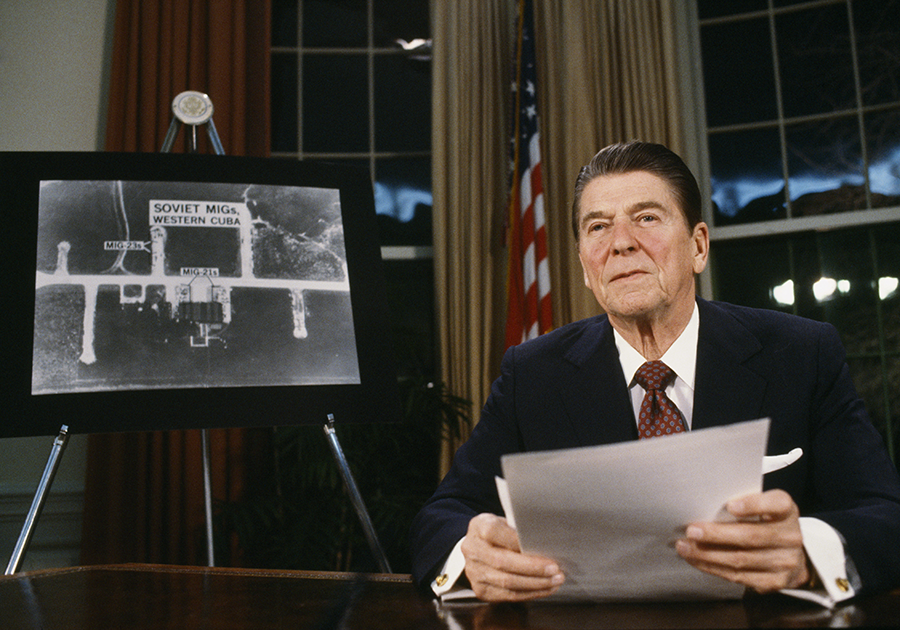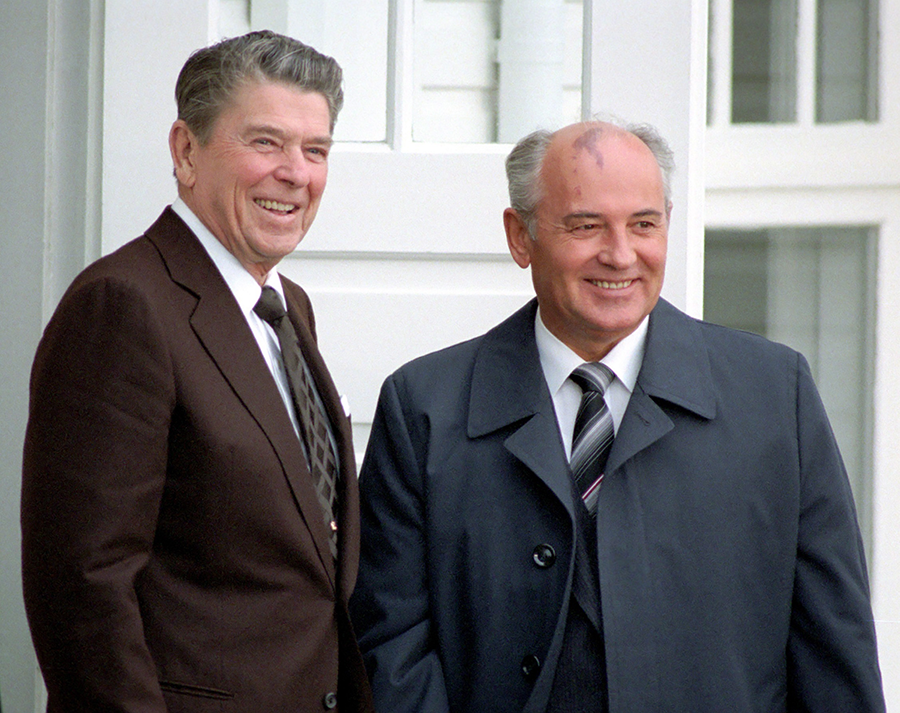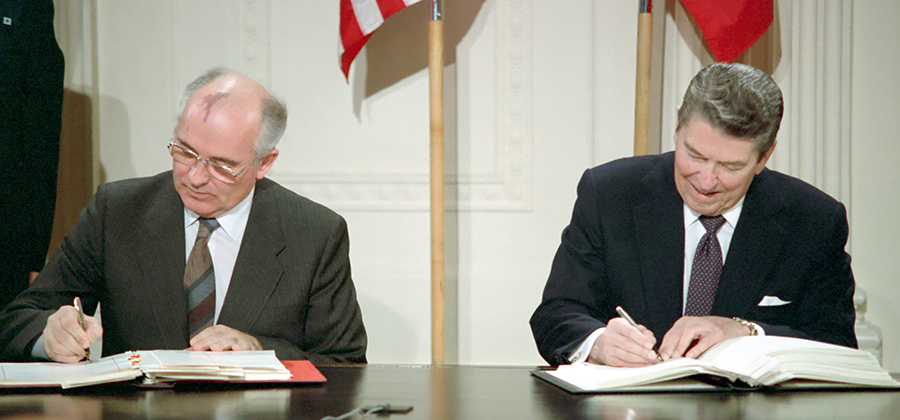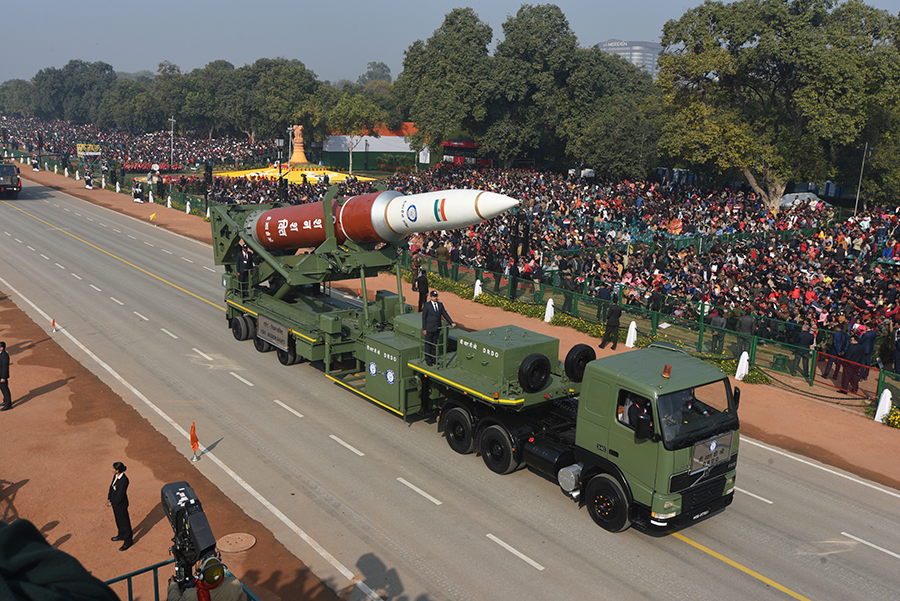The Enduring Impact of Reagan’s Strategic Defense Initiative
September 2023
By Aaron Bateman
This year marks the 40th anniversary of President Ronald Reagan’s unexpected call for U.S. scientists to use their talents to develop a capability that would make nuclear weapons “impotent and obsolete.”
 Less than a year after that March 1983 speech, the White House established the Strategic Defense Initiative (SDI), more commonly and derisively known as “Star Wars,” to conduct research into a wide variety of advanced technologies that could be used for land- and space-based missile defense.
Less than a year after that March 1983 speech, the White House established the Strategic Defense Initiative (SDI), more commonly and derisively known as “Star Wars,” to conduct research into a wide variety of advanced technologies that could be used for land- and space-based missile defense.
Immediately after Reagan’s call for an alternative to nuclear deterrence, the very prospect of a missile defense program became the source of intense controversy around the world. Experts questioned its technical feasibility and debated its potential impact on the superpower strategic balance. Moreover, SDI exacerbated anxieties about the arms race moving into outer space.
With growing access to thousands of relevant documents in the United States, western Europe, and the former Soviet Union, it is now possible to analyze more fully the origins and evolution of SDI and its relationship with arms control in the last days of the Cold War. In key respects, SDI emerged out of the intensifying militarization of space in the 1970s. Nevertheless, the prospect of space-based missile defense in the 1980s quickly became the primary obstacle to progress in the U.S.-Soviet strategic arms dialogue. Despite the fact that SDI never came to fruition, it was one of the most significant impediments to the establishment of new arms control limits in space. Four decades later, SDI continues to shape the international dialogue on strategic stability, and it is a key part of the genealogy of the present anxieties about spiraling insecurity in the cosmos.
Not a Sanctuary
In the decade prior to the establishment of SDI, transformations already were taking place in the way that the Soviet Union and the United States used space for military aims. Their long-standing commitment to the “peaceful use of outer space” did not preclude military and intelligence activities, such as reconnaissance, communications, and nuclear early warning. As détente emerged in the 1970s, space technologies served as a means of verifying arms control treaties and as a prominent symbol of the new turn in relations between Moscow and Washington. In 1972, Soviet Premier Alexei Kosygin and U.S. President Richard Nixon signed an agreement to cooperate in space, leading to the 1975 Apollo-Soyuz mission.
Astronauts and cosmonauts shaking hands in space after their Apollo and Soyuz spacecraft docked was intended to be the apotheosis of détente. Yet less than a year after that mission, the Soviet Union resumed testing anti-satellite (ASAT) weapons systems as détente appeared to be faltering. Concurrently, the Soviet Union and the United States had begun to integrate satellites more fully into military operations for functions such as precision targeting of enemy forces. Consequently, a special panel commissioned by President Gerald Ford concluded that “treating space as a sanctuary, [was] neither enforceable nor verifiable.”1 With this observation in mind, in his last 48 hours in office, Ford approved a new U.S. ASAT weapons program.
Upon entering the White House, President Jimmy Carter sought to prevent an arms race in space. He stressed to his Soviet counterparts that limits on ASAT weapons systems needed to be included in the ongoing arms control negotiations. To this end, representatives from Moscow and Washington in 1978 and 1979 went through multiple rounds of negotiations to limit these weapons, but disagreements concerning what should be constrained prevented them from being included in the second Strategic Arms Limitation Talks treaty signed by Carter and Soviet leader Leonid Brezhnev in June 1979. After the Soviet invasion of Afghanistan in December of that year, progress in arms control ground to a halt. Fundamentally, before Reagan even came into office, superpower competition in space was intensifying.
Seizing the High Ground
After his inauguration, Reagan began making space technologies a prominent part of his national strategy. His administration maintained that space projects would elevate U.S. prestige on the international stage and strengthen U.S. military power. In contrast to prior administrations, Reagan overtly highlighted the growing role of U.S. military activities in space. His first space policy, released to the public in 1982, discussed the need to deploy an ASAT weapons capability as soon as possible that would be used to “deter threats to space systems of the United States and its allies.”2
 During his first two years in the White House, Reagan increasingly viewed space in militarily competitive terms. A White House space policy study initiated in December 1982 was based on the premise that “[t]he Soviet Union [had] initiated a major campaign to capture the ‘high ground’ of space.”3 After receiving an intelligence briefing on Soviet military space and strategic defense research, Reagan wrote in his diary that there was no question the Soviets were seeking military superiority in space.
During his first two years in the White House, Reagan increasingly viewed space in militarily competitive terms. A White House space policy study initiated in December 1982 was based on the premise that “[t]he Soviet Union [had] initiated a major campaign to capture the ‘high ground’ of space.”3 After receiving an intelligence briefing on Soviet military space and strategic defense research, Reagan wrote in his diary that there was no question the Soviets were seeking military superiority in space.
In the context of these military space developments, the prospect for space arms control looked increasingly grim. Moreover, key figures in the Reagan administration were openly skeptical of arms control in general. The president had long been a critic of the 1972 Anti-Ballistic Missile (ABM) Treaty, which he believed had shackled U.S. technological advantages. Regarding ASAT weapons systems specifically, officials in the Pentagon argued that an ASAT arms control agreement could not even be verified. Regardless, between 1981 and the beginning of 1983, space remained a peripheral topic in the arms control arena. Soviet-U.S. disagreement over intermediate-range nuclear forces and the prospective deployment of U.S. Pershing II missiles in Europe were much more prominent and contentious issues.
Space was quickly thrust into the center of the arms control debate after Reagan made the speech in March 1983 calling on U.S. scientists to develop a capability to render nuclear weapons “impotent and obsolete.” Although that date is often identified as the birth of SDI, the program was not formally established until January 1984. Yet, in that nearly one-year period, space and strategic defense became issues in superpower and transatlantic relations. Within a few days of the speech, Soviet leader Yuri Andropov accused the United States of seeking to gain a first-strike capability against Soviet strategic forces. He further alleged that the United States sought to “militarize outer space,” ignoring the fact that space had long been militarized.
By the summer of 1983, the Soviet Union was showing greater enthusiasm for space arms control. Andropov told a delegation of U.S. senators in August that Moscow would enact an ASAT weapons testing moratorium, and he shared his wish that the Soviet Union and the United States would dismantle their ASAT weapons systems. His eagerness for ASAT weapons limits was in stark contrast to Soviet attitudes during the Soviet-U.S. negotiations in the late 1970s. Similarly, officials in Western Europe openly supported a superpower ASAT weapons arms control agreement.
What accounts for the prominent emergence of ASAT arms control proposals in the wake of Reagan’s SDI announcement? Most importantly, limits on ASAT weapons systems would have constrained the development of strategic defense in the long term because they were dependent on many of the same capabilities. Donald Kerr, the head of Los Alamos National Laboratory, observed in 1983 that “many of the more advanced technologies that now are being considered for anti-satellite use are virtually indistinguishable from [anti-ballistic missile] technologies.”4 Consequently, the Reagan administration concluded that the Soviet Union wanted to use ASAT weapons arms control as a mechanism to kill SDI.
The Nuclear and Space Talks
It finally appeared that there might yet be hope for arms control in January 1985 when Soviet and U.S. officials agreed to three arms negotiation forums on strategic nuclear weapons, intermediate-range nuclear forces, and space and defensive arms, collectively known as the Nuclear and Space Talks. Unexpectedly, Soviet leader Konstantin Chernenko, who had succeeded Andropov in February 1984, died on March 10, 1985, the day before the new arms control talks were set to begin. Shortly thereafter, a young party official named Mikhail Gorbachev took the reins of the Soviet Union at this critical juncture in superpower relations.
 Tension over SDI remained at the forefront of Soviet-U.S. conversations concerning arms limits. By this point, Soviet defense and technical experts had completed a study on the feasibility of SDI and concluded that a leakproof defense was not possible. Nevertheless, key Soviet officials remained concerned about the implications of the U.S. program, which involved research into a wide variety of advanced technologies with missile defense and other applications. For example, more advanced command and control software and space-based sensors potentially would widen the information technology gap between Soviet and U.S. military forces. Moreover, some defense analysts in the Kremlin worried that even a partially functioning space-based missile defense could erode the credibility of the Soviet Union’s nuclear deterrent. Notably, there were a range of views on SDI within the Soviet government, and the lack of clarity about the future course of SDI research only created more anxiety in the Kremlin about the program’s long-term implications.
Tension over SDI remained at the forefront of Soviet-U.S. conversations concerning arms limits. By this point, Soviet defense and technical experts had completed a study on the feasibility of SDI and concluded that a leakproof defense was not possible. Nevertheless, key Soviet officials remained concerned about the implications of the U.S. program, which involved research into a wide variety of advanced technologies with missile defense and other applications. For example, more advanced command and control software and space-based sensors potentially would widen the information technology gap between Soviet and U.S. military forces. Moreover, some defense analysts in the Kremlin worried that even a partially functioning space-based missile defense could erode the credibility of the Soviet Union’s nuclear deterrent. Notably, there were a range of views on SDI within the Soviet government, and the lack of clarity about the future course of SDI research only created more anxiety in the Kremlin about the program’s long-term implications.
Because testing and deploying space-based defenses would have violated the ABM Treaty, the boundaries set in that treaty became the subject of visceral debate, with disagreement over testing missile defense components in space coming to a head at the Soviet-U.S. summit in Reykjavik, Iceland, in the fall of 1986. In multiple meetings, Reagan pledged to Gorbachev that SDI was only defensive in nature and that the United States ultimately would share the fruits of its SDI research with the Soviet Union. Gorbachev doubted the sincerity of Reagan’s promise to provide missile defense hardware to Moscow when the United States would not even share its milk factory technologies with the Soviet Union. Unexpectedly, the two leaders agreed that they could eliminate “all [U.S. and Soviet] nuclear weapons,” but Gorbachev added the contingency that SDI be confined to the laboratory.5 After Reagan refused to accept any limits on SDI, the two leaders departed Reykjavik without a deal in hand. Nevertheless, the meeting was an important step in improving superpower relations.
Around this same time, the Pentagon was putting together a concept for a first-phase strategic defense system that would include kinetic interceptors, housed in what were referenced as orbiting space “garages,” designed to destroy ballistic missiles in their boost phase of flight. Problematically, however, these garages would be sitting ducks for Soviet ASAT weapons. With these technical details in mind, Gorbachev pledged to Reagan that the Soviet Union would counter any deployed strategic defense system with asymmetric countermeasures, such as ASAT weapons and faster-burn intercontinental ballistic missiles (ICBMs). Immediately after Reykjavik, the Politburo asked the Soviet Ministry of Defense to hasten work on countermeasures for a deployed strategic defense system.
To break the impasse in the arms control dialogue, Gorbachev made the historic decision in February 1987 to delink SDI from progress on negotiations concerning intermediate-range nuclear forces. He was motivated in large part to curb the arms race as an element of widespread economic reforms. Notably, pressure from SDI was not a significant factor in the delinkage decision. There were also technical factors at play. Advisers to Gorbachev had convinced him that asymmetric countermeasures would be a viable, cost-effective solution should the United States move forward with the deployment of a strategic defense system.
Gorbachev’s delinkage decision paved the way in December 1987 for the signing of the Intermediate-Range Nuclear Forces Treaty, which led to the elimination of an entire class of U.S. and Soviet ground-based missiles. Nevertheless, SDI remained a source of contention in the strategic arms forum of the Nuclear and Space Talks. In this context, Reagan offered a defense and space treaty that would allow specific kinds of missile defense tests in space and tried to convince Gorbachev to drop the linkage between SDI and the Strategic Arms Reduction Treaty (START). Yet, Gorbachev refused both of these proposals. Even with their military’s missile defense countermeasures, key Soviet officials still worried that a U.S. strategic defense system could undermine the Soviet nuclear deterrent and that SDI would have other applications that could widen the technology gap between the two countries. Due in large part to these disagreements concerning SDI, there would be no START agreement before Reagan left office.
Aside from constraints on strategic defense, a range of other limits on space activities was contemplated. The Soviet Union and the United States could have agreed to eliminate low-altitude ASAT weapons systems, as well as prohibit high-altitude ASAT weapons systems, which did not exist, that might be deployed to attack satellites used for nuclear command and control, among other functions. Additionally, there was U.S. interest in prohibiting space-to-earth weapons, which also did not exist. U.S. Secretary of Defense Caspar Weinberger vehemently opposed this initiative, arguing that “we ought not to give up any flexibility now.”6 In the end, Reagan would not accept any limits on military space activities due to their implications for SDI. Because space technologies were increasingly important for modern warfare, prospective limits on them were seen as undercutting an arena of distinct U.S. advantage.
SDI After the Cold War
When President George H.W. Bush came into office, the Soviet-U.S. relationship was in a remarkably different place than when SDI was established, and the changing geopolitical environment forced the program’s advocates to come up with a new justification for strategic defense. Significantly, as the Soviet threat diminished, it became difficult to continue spending billions of dollars on SDI.
In the late 1980s, SDI program managers adopted a new concept for space-based missile defense system called Brilliant Pebbles. Rather than housing interceptors in garages that were sitting ducks for ASAT weapons, Brilliant Pebbles comprised individual interceptors with sensors onboard that would allow them to track and destroy ballistic missiles. They were cheaper and more survivable than the original concept, at least in theory. Cost and survivability aside, deploying these weapons would still require revisions to or the elimination of the ABM Treaty.
The Soviet-U.S. arms control negotiations reached new heights after a September 1989 announcement that the Soviet Union would drop its requirement that an agreement be reached concerning SDI and the ABM Treaty before making progress on START. Moscow stressed, however, that if Washington moved ahead with space-based missile deployment in the future, it reserved the right to withdraw from START. Regardless, SDI was no longer an impediment to progress in nuclear arms reductions.
With the Cold War receding, SDI proponents tried to use the threat of missile proliferation to so-called rogue states as a new justification for space-based missile defense. To save SDI, these advocates proposed a scaled-down version of strategic defense called Global Protection Against Limited Strikes that would involve fewer numbers of Brilliant Pebbles weapons in orbit. Problematically for the Pentagon, between 1990 and 1992, there were three tests of the Brilliant Pebbles weapons system, all of which were deemed failures to varying degrees. Although there was bipartisan support for limited land-based missile defense systems, space-based interceptors were viewed as technologically immature and politically risky. Indeed, there was little appetite for moving beyond the ABM Treaty and potentially undermining the recent progress in nuclear arms control.
The death knell rang for space-based missile defense interceptors when Bill Clinton became president in 1993. Shortly after taking office, he reoriented U.S. strategic defense, now called national missile defense, toward land-based interceptors and cut funding for the Brilliant Pebbles program. A little more than a decade after its establishment, SDI was brought down to earth.
SDI’s Legacy
In contrast with his predecessor, President George W. Bush viewed missile defense as a critical tool for protecting the United States against “rogue regimes” that sought nuclear weapons. To this end, he withdrew the United States from the ABM Treaty in 2002, 30 years after the pact came into force. He also established the Missile Defense Agency, the modern incarnation of the Strategic Defense Initiative Organization that managed SDI research and development. With the Pentagon’s resources soon focused on U.S. military operations in the Middle East, however, space-based missile defense would not be revived.
Presently, U.S. missile defense is built primarily around land- and sea-based interceptors with sensors in space for detecting missile threats. Due to the growing number of counterspace capabilities—systems designed to degrade or destroy satellites—the Department of Defense is now pushing for a larger number of missile tracking systems in orbit so that the overall missile defense architecture is more resilient.7 This concept for a larger number of tracking systems in space was a key part of the first-phase strategic defense system plans developed under SDI aegis in the late 1980s and early 1990s. Fundamentally, SDI is still here, although in a reduced form.
The ghost of SDI is ever present in the current international dialogue on space security as well. Today, there are growing fears about a space arms race as multiple countries develop kinetic and nonkinetic weapons for interfering with satellites. Concurrently, there is greater attention being devoted to developing responsible norms of behavior in space. These issues are not fundamentally new; rather, they were part of the arms control dialogue in the 1980s but left unresolved at the end of the Cold War and have become urgent again only in the past decade. The situation in space today is far more complicated, however, due to the growing number of governmental and commercial space actors.
 The technological connection between missile defense systems and ASAT weapons systems remains a persistent problem in the space security arena. Due to this missile defense-ASAT weapons entanglement, the proliferation of advanced missile defense capabilities simultaneously means the proliferation of ASAT-capable systems. India’s recent ASAT weapons test, which grew out of its missile defense program, is a case in point. Just as in the 1980s, attempting to separate missile defense from space in any dialogue on arms control will be impossible.
The technological connection between missile defense systems and ASAT weapons systems remains a persistent problem in the space security arena. Due to this missile defense-ASAT weapons entanglement, the proliferation of advanced missile defense capabilities simultaneously means the proliferation of ASAT-capable systems. India’s recent ASAT weapons test, which grew out of its missile defense program, is a case in point. Just as in the 1980s, attempting to separate missile defense from space in any dialogue on arms control will be impossible.
For China and Russia, the memory of SDI looms large in their perspectives on current U.S. military space strategy. A recent study found that SDI is one of the most referenced U.S. military space programs in Chinese defense writings.8 Similarly, Russian military publications identify SDI as a core element of the alleged space superiority objectives of the United States.9 Fundamentally, SDI remains a significant factor in Chinese and Russian narratives about space security.
The U.S. commitment to freedom of action in space, due in large part to SDI, was a primary impediment to space arms control in the 1980s. From a military standpoint, it is understandable that the United States wanted to maintain freedom of action in an arena in which it had significant advantages. Moreover, it is unlikely that a new space arms control treaty would have forestalled the many security challenges in space today. Nevertheless, the lack of progress in space arms control in the 1980s eliminated the prospect for establishing a precedent that could have helped provide a framework for international engagement on the challenges associated with stability in space today.
ENDNOTES
1. Memo from David Elliot to Brent Scowcroft, Final Report of the Ad Hoc NSC Space Panel - Part II: U.S. Anti-Satellite Capabilities, November 3, 1976, Ford Library, 5.
2. National Security Decision Directive-42, “National Space Policy,” July 4, 1982, CREST, CIA-RDP88B00838R000300510026-0.
3. National Security Study Directive Number 13-82, “National Space Strategy,” December 15, 1982, CREST, CIA-RDP85M00364R000400550064-1.
4. Donald Kerr, “Implications of Anti-Satellite Weapons for ABM Issues,” George Keyworth Files, RAC Box 14, Ronald Reagan Presidential Library.
5. Memorandum of Conversation (3:25-4:30pm and 5:30-6:50pm), Reagan, Gorbachev et al., October 12, 1986, FRUS, 1981-1988 Volume V, Soviet Union, March 1985-October 1986.
6. Minutes of National Security Planning Group Principals Meeting, “Arms Control - Shultz Meeting in Moscow,” April 3, 1987, FRUS, 1981-1988, Volume XI, START I.
7. Rachael Zisk, “The National Defense Space Architecture (NDSA): An Explainer,” U.S. Space Development Agency, December 5, 2022, https://www.sda.mil/the-national-defense-space-architecture-ndsa-an-explainer/.
8. Alexis A. Blanc et al., “Chinese and Russian Perceptions of and Responses to U.S. Military Activities in the Space Domain,” RAND Corp., 2022, p. 9, https://www.rand.org/content/dam/rand/pubs/research_reports/RRA1800/RRA1835-1/RAND_RRA1835-1.pdf.
Aaron Bateman, an assistant professor of history and international affairs at George Washington University, has published widely on intelligence, transatlantic relations, military space policy, and arms control during the Cold War. His book Weapons in Space: Technology, Politics, and the Rise and Fall of the Strategic Defense Initiative is scheduled for publication next year.
